#Magdalena Carmen Frida Kahlo y Calderón
Text

Frida Kahlo, Self Portrait dedicated to Marte R. Gomez, 1946
Magdalena Carmen Frida Kahlo y Calderón (6 July 1907 – 13 July 1954) was a Mexican painter known for her many portraits, self-portraits, and works inspired by the nature and artifacts of Mexico. Inspired by the country's popular culture, she employed a naïve folk art style to explore questions of identity, postcolonialism, gender, class, and race in Mexican society. Her paintings often had strong autobiographical elements and mixed realism with fantasy. In addition to belonging to the post-revolutionary Mexicayotl movement, which sought to define a Mexican identity, Kahlo has been described as a surrealist or magical realist. She is also known for painting about her experience of chronic pain. via Wikipedia
#FridaKahlo #mexicanart #womensart #mexicanartist #artbywomen #PalianShow #artherstory #greatartist #GreatWomenArtists
#Frida Kahlo#self portrait#art by women#art#palianshow#women's art#art herstory#Magdalena Carmen Frida Kahlo y Calderón
6 notes
·
View notes
Text




マグダレーナ・カルメン・フリーダ・カーロ・イ・カルデロン
メキシコの画家です。('ω')・・ごぞんじだった?
#AI#生成AI#AIart#AIイラスト#bingimagecreator#DALLE#AIArtworks#illust#AI画像#メキシコ#mexico#アート#art#フリーダカーロ#Magdalena Carmen Frida Kahlo y Calderón#画家#painter#シュルレアリスム#マジックリアリズム#surrealism#magicrealism
0 notes
Text
Frida Kahlo (nacida Magdalena del Carmen Frida Kahlo Calderón)
Uno de los rostros más famosos del mundo es el de Frida Kahlo (nacida Magdalena del Carmen Frida Kahlo Calderón).

Frida fue una pintora mexicana cuyos retratos nos mostraron un novedoso punto de vista de las formas femeninas con gran honestidad y belleza.
Autodidacta, Kahlo creó al menos 140 pinturas, así como decenas de dibujos y bocetos. La gran artista murió en 1954 y fue incinerada, aunque nunca se le practicó la autopsia, se determinó como causa oficial de su muerte una embolia pulmonar. Kahlo y su arte han sido inmortalizadas por la cultura mexicana y el discurso feminista.
#Frida Kahlo (nacida Magdalena del Carmen Frida Kahlo Calderón)#¿Historias cortas para no dormir y no tener pesadillas? ¡Caray que Tropa!#Pintora Surrealista
2 notes
·
View notes
Text


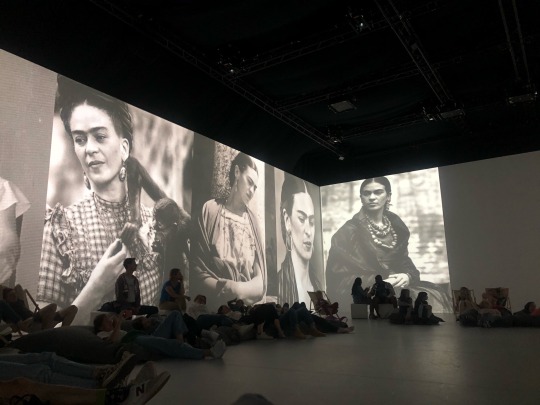
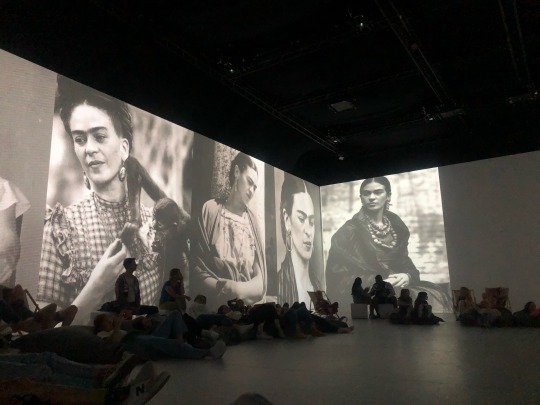
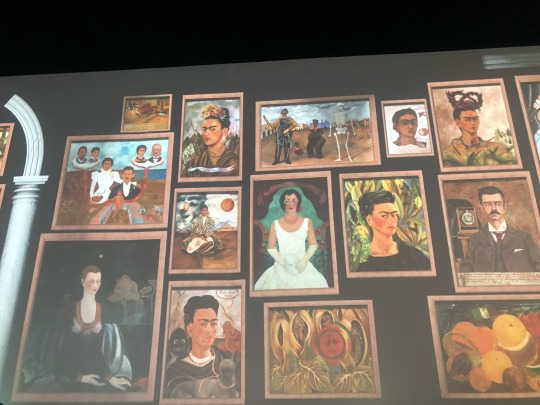




«VIVA FRIDA KAHLO» is the first immersive staging of the world-famous works of legendary Mexican artist and icon Frida Kahlo. A true sensory experience, an explosion of color and pure vitality! The 360-degree experience takes visitors to Mexico, to the "Casa Azul" in Coyoacán, where young Frida Kahlo, tied to her bed after a serious accident, begins to paint. Part1 Part2 Part3
"I'm not sick, I'm broken. But as long as I can paint, I'm glad I'm alive." (Frida Kahlo)
"Viva Frida Kahlo" is an experience for everyone: the visitors are literally drawn into Frida Kahlo's world. You experience the 1920s to the 1940s and immerse yourself in the colorful paintings and self-portraits as evidence of a life full of grace, pain and an unbroken will to live. Visitors to the exhibition move freely in space, complex all-round projections create exotic color worlds full of emotions and allow Frida Kahlo's works to be experienced in a way never seen before.
Kahlo's images, which appear almost tiny in the original, are brought to life with high-performance projectors and projected onto walls up to 24 meters long and 5.5 meters high, as well as onto the floor of the exhibition hall. For an all-round experience of the senses, a speaker in the role of the artist leads through the emotional world of the painter, who was already emancipated back then, with original quotations. A specially composed soundtrack underscores the immersive staging acoustically.
This creates an immersive overall experience for visitors, which combines transformation, reinterpretation and light art in line with today's zeitgeist. An event not only for Frida Kahlo fans, but for everyone who wants to experience art in this new multimedia form, interact with it and be carried away from everyday life. "Viva Frida Kahlo - Immersive Experience" is a truly Mexican color explosion of the great Frida Kahlo and her impressive life.
Frida Kahlo de Rivera (born Magdalena Carmen Frieda Kahlo y Calderón on July 6, 1907 in Coyoacán, Mexico City – died July 13, 1954 in Coyoacán, Mexico City) was a Mexican painter. She is one of the most important representatives of a popular development of Surrealism, whose work sometimes shows elements of New Objectivity. @boanerges20 🥹
Soundtrack: Luz de luna by Chavela Vargas 🌜
#l o v e#Viva Frida Kahlo#frida kahlo#5/2023#female artists#female art#photographer#iphonography#art installation#Museum#Vienna#mexican artist#Mexico#x-heesy#fucking favorite#now playing#music and art#contemporaryart
66 notes
·
View notes
Text

Magdalena Carmen Frida Kahlo Calderón (Coyoacán, Ciudad de México, 6 de julio de 1907-13 de julio de 1954), conocida como Frida Kahlo, fue una pintora mexicana. Su obra gira temáticamente en torno a su biografía y a su propio sufrimiento. Fue autora de 150 obras, principalmente autorretratos, en los que proyectó sus dificultades por sobrevivir. También es considerada como un icono pop de la cultura de México.
Su vida estuvo marcada por el infortunio de sufrir un grave accidente en su juventud que la mantuvo postrada en cama durante largos periodos, llegando a someterse a hasta 32 operaciones quirúrgicas. Llevó una vida poco convencional. La obra de Frida y la de su marido, el pintor Diego Rivera, se influyeron mutuamente. Ambos compartieron el gusto por el arte popular mexicano de raíces indígenas, inspirando a otros pintores mexicanos del periodo posrevolucionario.
En 1939 expuso sus pinturas en Francia gracias a una invitación de André Breton, quien intentó convencerla de que eran «surrealistas», aunque Kahlo decía que esta tendencia no correspondía con su arte ya que ella no pintaba sueños sino su propia vida. Una de las obras de esta exposición (Autorretrato-El marco, que actualmente se encuentra en el Centro Pompidou) se convirtió en el primer cuadro de un artista mexicano adquirido por el Museo del Louvre. Hasta entonces, Frida Kahlo había pintado solo privadamente y a ella misma le costó admitir que su obra pudiese tener un interés general. Aunque gozó de la admiración de destacados pintores e intelectuales de su época como Pablo Picasso, Vasili Kandinski, André Breton, Marcel Duchamp, Tina Modotti y Concha Michel, su obra alcanzó fama y verdadero reconocimiento internacional después de su muerte, especialmente a finales de los años de 1980 y principios de 1990 por coleccionistas.
#art#culture#pintura#biography#photography#books and libraries#spilled thoughts#writing#literature#travel
19 notes
·
View notes
Text
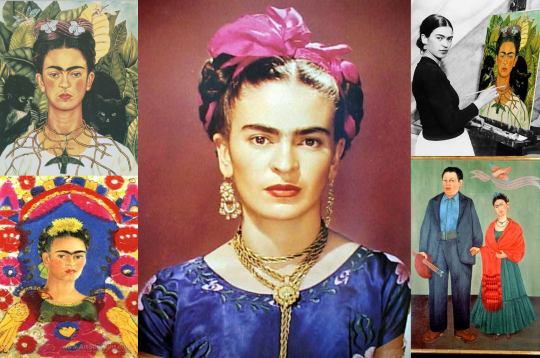
FRIDA KAHLO
O trabalho de Frida Kahlo como artista permaneceu relativamente desconhecido até finais dos anos 70, quando o seu trabalho foi redescoberto por historiadores de arte e ativistas políticos.
No início dos anos 90, ela tinha-se tornado não só uma figura reconhecida na história da arte, mas também considerada como um ícone para o Movimento Chicano, o movimento feminista e o movimento LGBT.
O trabalho de Kahlo tem sido celebrado internacionalmente como emblemático das tradições nacionais e indígenas mexicanas e por feministas pelo que é visto como a sua representação intransigente da experiência e forma feminina.
Tragédia, amor e arte são palavras que definem a vida de Magdalena Carmen Frida Kahlo y Calderón.
#discernir#pensamentos#conhecimento#refletir#sabedorias#art#vidaeobra#sairdailusão#autoconhecimento#cosas de la vida#citas de la vida
2 notes
·
View notes
Text

Frida Kahlo Takes A Family Portrait Wearing Her Iconic Three Piece Suit, Accessorised With A Cane // Mexico, 1924
* * * *
Magdalena Carmen Frida Kahlo y Calderón (6 July 1907 – 13 July 1954) was a Mexican painter known for her many portraits, self-portraits, and works inspired by the nature and artifacts of Mexico. Inspired by the country's popular culture, she employed a naïve folk art style to explore questions of identity, postcolonialism, gender, class, and race in Mexican society. Her paintings often had strong autobiographical elements and mixed realism with fantasy. In addition to belonging to the post-revolutionary Mexicayotl movement, which sought to define a Mexican identity, Kahlo has been described as a surrealist or magical realist. She is known for painting about her experience of chronic pain.
[Society Retro Hub]
+
“I am that clumsy human, always loving, loving, loving. And loving. And never leaving.”
― Frida Kahlo
46 notes
·
View notes
Text
Frida Kahlo (1907-1954) Iconic Mexican Painter
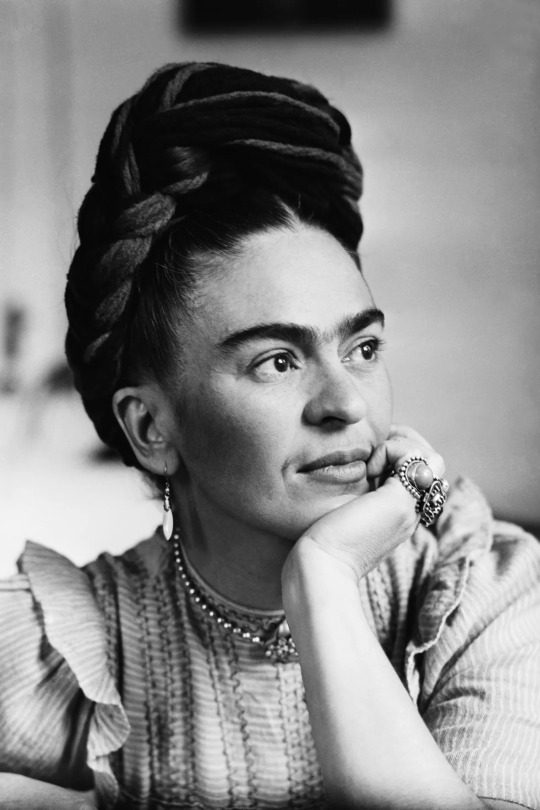
Magdalena Carmen Frida Kahlo y Calderón, known as Frida Kahlo, was born on July 6, 1907, in Coyoacán, a suburb of Mexico City. She grew up in a politically active and artistic family. Kahlo's father, Guillermo Kahlo, was a photographer of German descent, and her mother, Matilde Calderón y González, was of indigenous and Spanish heritage. Frida developed an interest in art from an early age, but her aspirations to become a doctor were thwarted when she experienced a debilitating accident at the age of 18. She was injured in a bus accident that dealt severe injuries throughout her body but the most damaging were to her spine and pelvis. This would forever change her life to be full of surgeries, pain, and recoveries, but sparked her inspiration for her art.
In 1929, Frida Kahlo married the renowned Mexican painter Diego Rivera, who became a significant influence on her artistic development. She first met him at the National Preparatory School in Mexico City. Their marriage was marked by both passion and turbulence. They had a complex relationship characterized by infidelity, separations, and reconciliations; not to mention the two had a 20-year age gap. Rivera is quoted saying Kahlo is “…the most wonderful part of my life" despite cheating on her multiple times. The couple also struggled to conceive children, all of this fueling Frida's complexity in her work, an example is the painting “The Henry Ford Hospital”. Frida's bisexuality and her affairs with both men and women further contributed to the dynamics of their marriage as well. Despite her rough life circumstances, she had a successful art career, she is celebrated for her vibrant and introspective self-portraits, which explored themes of identity, pain, and resilience. Despite enduring chronic physical and emotional pain resulting from her accident and subsequent health issues, Kahlo channeled her experiences into her art. Her paintings often depicted her physical and emotional suffering, along with symbols of Mexican culture, folklore, and politics. Kahlo's unique style combined elements of surrealism, symbolism, and indigenous Mexican art, making her a pioneering figure in the art world. Frida Kahlo's work gained recognition both during her lifetime and posthumously. She had her first solo exhibition in Mexico in 1953, and her art attracted the attention of notable artists such as Pablo Picasso and André Breton. However, it was in the late 1970s and 1980s, long after her death, that Kahlo's art gained widespread international acclaim. Her deeply personal and emotive paintings resonated with audiences, and she became an iconic figure in feminist and LGBTQ+ art movements.

Picture: Self-Portrait with Thorn Necklace and Hummingbird-1940
Frida's art is still prevalent and talked about today, and her legacy is a source of inspiration for multiple groups of people around the world. Kahlo's unapologetic exploration of female identity and her depiction of the female experience have made her an enduring symbol of feminist empowerment. Through her art, she challenged societal norms and patriarchal constraints, providing a voice for women who had long been silenced or marginalized. Her deep connection to her Mexican heritage is evident in her art, which often incorporated Mexican folk art and symbols. She celebrated indigenous culture and the struggles of the Mexican people, helping to promote Mexican identity and pride both within Mexico and internationally. Frida's artistic style and thematic exploration have inspired countless contemporary artists. Her powerful portrayal of pain, identity, and the human experience continues to resonate with artists and audiences worldwide. Kahlo's influence can be seen in various forms of visual art, as well as in fashion, music, and popular culture.
Frida Kahlo's legacy extends beyond her own artwork. Her life story, resilience, and ability to find beauty in the face of adversity have inspired generations. She remains an enduring symbol of strength, creativity, and self-expression, encouraging individuals to embrace their authentic selves and embrace the transformative power of art. As an artist and cultural icon goes far beyond her extraordinary paintings… encompassing boldness, resilience, and commitment to self-expression have left an indelible mark on the art world, inspiring generations of artists and serving as a beacon of empowerment for marginalized communities.
Interested in viewing her work?:
For more information on Frida Kahlo:
Time log: 00:54:48
3 notes
·
View notes
Text
#tbt de hoje é a visitação na casa da Aniversariante do dia: Frida Kahlo.
Magdalena Carmen Frida Kahlo y Calderón, ou simplesmente, Frida Kahlo foi uma artista mexicana que nasceu em 06 de julho de 1907 em Coyocán, distrito da Cidade do México. A Casa Azul onde a artista nasceu, morreu e viveu boa parte de sua vida, atualmente se transformou no Museu Frida Kahlo, anos após a morte da artista. O espaço está localizado no bairro de Coyocán na região sul da capital do México. O Museu conserva vários objetos e quadros de Frida. Conheça um pouco mais sobre o assunto no post no blog
#frida#frida kahlo#mexico#cdmx#tbt#viajar#trips#travel#travelgram#amoviajar#wanderlust#latinoamerica#america latina#trip
5 notes
·
View notes
Text

Which famous 20th-century painter lived in 'La Casa Azul' (The Blue House)?
The Frida Kahlo Museum, also known as 'La Casa Azul' (the Blue House) due to its cobalt-blue walls, is a historic house and art museum dedicated to the life and work of Mexican artist Frida Kahlo. It is located in Mexico City and was Kahlo's birthplace, home and death place. In 1957, her husband Diego Rivera donated the home and its contents in order to turn it into a museum.
Magdalena Carmen Frida Kahlo y Calderón (1907-1954) was a Mexican painter, usually known as Frida Kahlo. She is remembered for her surreal and very personal works. At 18, due to a traffic accident, she became disabled and had periods of severe pain for the rest of her life. After this accident, Kahlo took up painting and used the things that had happened to her as inspiration. Her paintings are often shocking in the way they show her pain and the harsh lives of women.
Kahlo's attention to female themes and the honesty in her paintings made her something of a feminist cult figure in the last decades of the 20th century. Some of her work is seen at the Frida Kahlo Museum, along with Mexican folk art, pre-Hispanic artefacts, photographs, memorabilia, and personal items.
3 notes
·
View notes
Text

Frida Kahlo: “I used to think I was the strangest person in the world but then I thought there are so many people in the world, there must be someone just like me who feels bizarre and flawed in the same ways I do. I would imagine her, and imagine that she must be out there thinking of me too. Well, I hope that if you are out there and read this and know that, yes, it's true I'm here, and I'm just as strange as you.”
Repost Campbells Loft FB 2013 🙏🏼 thank you @art.by.women_women.in.arts
Magdalena Carmen Frida Kahlo y Calderón (Spanish pronunciation: [ˈfɾiða ˈkalo]; 6 July 1907 – 13 July 1954)was a Mexican painter known for her many portraits, self-portraits, and works inspired by the nature and artifacts of Mexico. Inspired by the country's popular culture, she employed a naïve folk art style to explore questions of identity, postcolonialism, gender, class, and race in Mexican society. Her paintings often had strong autobiographical elements and mixed realism with fantasy. In addition to belonging to the post-revolutionary Mexicayotl movement, which sought to define a #Mexicanidentity, #Kahlo has been described as a surrealist or magical realist. She is also known for painting about her experience of chronic pain. Via Wikipedia
4 notes
·
View notes
Text
1-.Vida de Frida Kahlo
Frida Kahlo (1907-1954)
Nació en 1907 y murió en 1954 en Coyoacán, Ciudad de México. Su nombre completo era Magdalena Carmen Frida Kahlo Calderón. Estudió en el Colegio Alemán y en la Escuela Nacional Preparatoria de la Ciudad de México. En 1925, sufrió un trágico accidente cuyas consecuencias padeció hasta su muerte.
La evidente limitación motriz, así como las constantes operaciones quirúrgicas y tratamientos médicos hicieron que Kahlo se desarrollara de modo diferente y con frecuencia se viera impedida de participar con otros niños. Varios de los cuadros que luego pintara en su vida adulta reflejan la temática de la soledad de su infancia. Un ejemplo que se cita con frecuencia es la obra de 1938 Cuatro habitantes de Ciudad de México, un óleo sobre metal de 32,4 x 47,6 cm, que muestra una pequeña niña sentada sobre una superficie en altura y ataviada con tehuana. La niña parece abandonada y triste, chupándose el dedo con desolación. Otro cuadro de ese mismo año (Niña con máscara de muerte o Ella juega sola), que Frida pintó en dos versiones, muestra a una pequeña niña de unos cuatro años de edad con una máscara de calavera.
Mientras la ambivalencia de sentimientos de amor y odio caracterizó el vínculo de Frida Kahlo con su madre, la relación con su padre siempre fue de mucho cariño y cercanía. Y se hizo aún más estrecha tras la enfermedad de poliomielitis de Frida, puesto que fue su padre quien principalmente la acompañó en sus ejercicios y la guio en los programas de rehabilitación. Frida, a su vez, fue testigo de los continuos y misteriosos desmayos de su padre, para los que en su temprana infancia nadie le ofreció explicación alguna. Se trataba de los frecuentes ataques epilépticos que sufría su padre como secuela de una temprana lesión cerebral. Con el tiempo, Frida aprendió a prestarle asistencia en estas circunstancias y finalmente se enteró de su causa. La experiencia compartida de lidiar contra el infortunio de las enfermedades unió a padre e hija con un lazo muy fuerte de solidaridad y empatía.
Juventud
Fue la tercera hija del fotógrafo Guillermo Kahlo y Matilde Calderón Gonzales, no se ha logrado identificar con exactitud la escuela a la que concurrió Frida antes de 1922. Repetidamente se ha señalado, sin embargo, que fue alumna del Colegio Alemán hasta 1921 y que allí habría obtenido su certificado escolar. Sin embargo, las actas del colegio no brindan una prueba de ello, ni tampoco tenía Frida el dominio del idioma alemán esperable, tal como ella misma escribió en una carta —redactada en idioma inglés— de 1949 a Hans- Joachim Kahlo, donde intentaba averiguar sobre sus ancestros y familia en Alemania.
Estudio en el colegio Alemán y a la Escuela Nacional Preparatoria de Ciudad de Mexico, prestigiosa institución educativa de Mexico, que recientemente había comenzado a admitir estudiantes de sexo femenino. Eran solo 35 mujeres, de un total de dos mil alumnos. Entonces aspiraba a estudiar medicina. En esta escuela conoció a futuros intelectuales y artistas mexicanos, como Salvador novo.
2 notes
·
View notes
Text
Frida Kahlo (nacida Magdalena del Carmen Frida Kahlo Calderón)
Uno de los rostros más famosos del mundo es el de Frida Kahlo (nacida Magdalena del Carmen Frida Kahlo Calderón).

Frida fue una pintora mexicana cuyos retratos nos mostraron un novedoso punto de vista de las formas femeninas con gran honestidad y belleza.
Autodidacta, Kahlo creó al menos 140 pinturas, así como decenas de dibujos y bocetos. La gran artista murió en 1954 y fue incinerada, aunque nunca se le practicó la autopsia, se determinó como causa oficial de su muerte una embolia pulmonar. Kahlo y su arte han sido inmortalizadas por la cultura mexicana y el discurso feminista.
#hFrida Kahlo (nacida Magdalena del Carmen Frida Kahlo Calderón)#¿Historias cortas para no dormir y no tener pesadillas? ¡Caray que Tropa!#Pintora Surrealista
0 notes
Text

Magdalena Carmen Frieda Kahlo y Calderón, (Frida Kahlo) fotografada em Nova York, em 1932, por Diego Rivera, com quem se casou em 1929
3 notes
·
View notes
Text









«VIVA FRIDA KAHLO» is the first immersive staging of the world-famous works of legendary Mexican artist and icon Frida Kahlo. A true sensory experience, an explosion of color and pure vitality! The 360-degree experience takes visitors to Mexico, to the "Casa Azul" in Coyoacán, where young Frida Kahlo, tied to her bed after a serious accident, begins to paint. Part1 Part2 Part4
"I'm not sick, I'm broken. But as long as I can paint, I'm glad I'm alive." (Frida Kahlo)
"Viva Frida Kahlo" is an experience for everyone: the visitors are literally drawn into Frida Kahlo's world. You experience the 1920s to the 1940s and immerse yourself in the colorful paintings and self-portraits as evidence of a life full of grace, pain and an unbroken will to live. Visitors to the exhibition move freely in space, complex all-round projections create exotic color worlds full of emotions and allow Frida Kahlo's works to be experienced in a way never seen before.
Kahlo's images, which appear almost tiny in the original, are brought to life with high-performance projectors and projected onto walls up to 24 meters long and 5.5 meters high, as well as onto the floor of the exhibition hall. For an all-round experience of the senses, a speaker in the role of the artist leads through the emotional world of the painter, who was already emancipated back then, with original quotations. A specially composed soundtrack underscores the immersive staging acoustically.
This creates an immersive overall experience for visitors, which combines transformation, reinterpretation and light art in line with today's zeitgeist. An event not only for Frida Kahlo fans, but for everyone who wants to experience art in this new multimedia form, interact with it and be carried away from everyday life. "Viva Frida Kahlo - Immersive Experience" is a truly Mexican color explosion of the great Frida Kahlo and her impressive life.
Frida Kahlo de Rivera (born Magdalena Carmen Frieda Kahlo y Calderón on July 6, 1907 in Coyoacán, Mexico City – died July 13, 1954 in Coyoacán, Mexico City) was a Mexican painter. She is one of the most important representatives of a popular development of Surrealism, whose work sometimes shows elements of New Objectivity. @frenchpsychiatrymuderedmycnut
Soundtrack: Luz de luna by Chavela Varga 🌙

#l o v e#Viva Frida Kahlo#frida kahlo#5/2023#iphonography#photographer#passion#Museum#female artists#female art#Vienna#mexican artist#mexico#contemporaryart#x-heesy#fucking favorite#music#now playing#spotify#music and art
35 notes
·
View notes
Photo






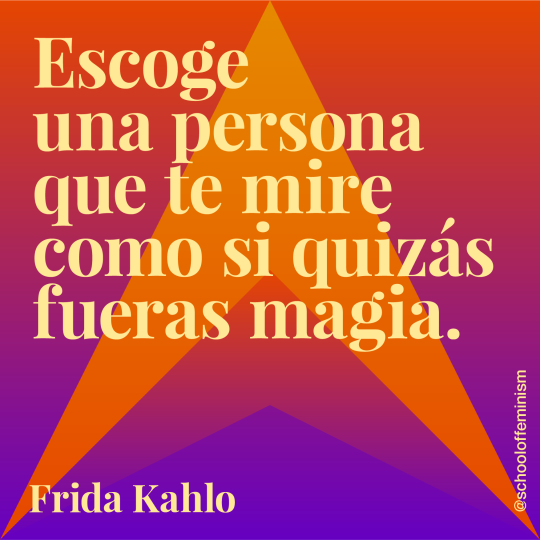
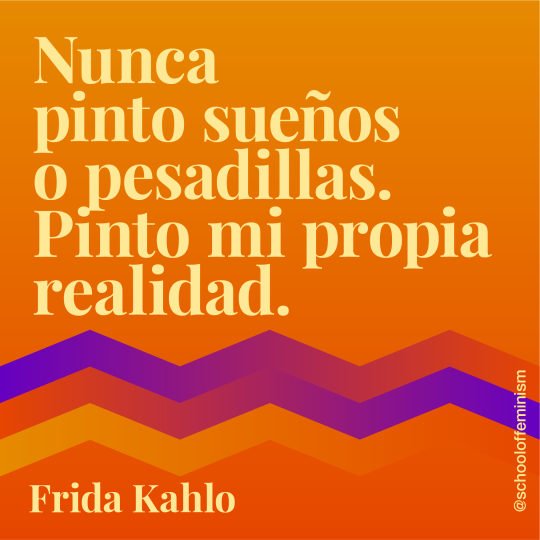
Magdalena Carmen Frida Kahlo Calderón (Coyoacán, Ciudad de México, 6 de julio de 1907- Ciudad de México, 13 de julio de 1954), conocida como Frida Kahlo, fue una pintora mexicana. Su obra gira temáticamente en torno a su biografía y a su propio sufrimiento. Fue autora de 150 obras, principalmente autorretratos, en los que proyectó sus dificultades por sobrevivir. También es considerada como un icono pop de la cultura de México.
Su vida estuvo marcada por el infortunio de sufrir un grave accidente en su juventud que la mantuvo postrada en cama durante largos periodos, llegando a someterse a hasta 32 operaciones quirúrgicas. Llevó una vida poco convencional.
La obra de Frida y la de su marido, el pintor Diego Rivera, se influyeron mutuamente. Ambos compartieron el gusto por el arte popular mexicano de raíces indígenas, inspirando a otros pintores mexicanos del periodo posrevolucionario.
En 1939 expuso sus pinturas en Francia gracias a una invitación de André Breton, quien intentó convencerla de que eran «surrealistas», aunque Kahlo decía que esta tendencia no correspondía con su arte ya que ella no pintaba sueños sino su propia vida. Una de las obras de esta exposición (Autorretrato-El marco, que actualmente se encuentra en el Centro Pompidou) se convirtió en el primer cuadro de un artista mexicano adquirido por el Museo del Louvre. Hasta entonces, Frida Kahlo había pintado solo privadamente y a ella misma le costó admitir que su obra pudiese tener un interés general. Aunque gozó de la admiración de destacados pintores e intelectuales de su época como Pablo Picasso, Vasili Kandinski, André Breton, Marcel Duchamp, Tina Modotti y Concha Michel, su obra alcanzó fama y verdadero reconocimiento internacional después de su muerte, especialmente a finales de los años de 1980 y principios de 1990 por coleccionistas como la cantante Madonna.
https://www.schooloffeminism.org/post/frida-kahlo-pintora-mexicana-reconocida-como-un-icono-pop-de-la-cultura-de-m%C3%A9xico
#Frida Kahlo#efemérides#educar en igualdad#educar en feminismo#school of feminism#Herstory#activismo por la igualdad#comunicación y activismo#feminismo#Feminist Revolution#revolutionmakers#la revolución será feminista
5 notes
·
View notes